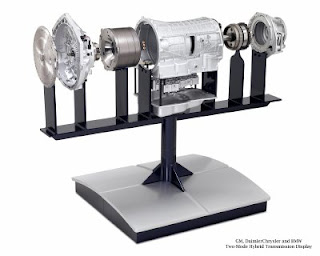GM May Eat Some Of Two-Mode Hybrid Cost
The good news? 25% fuel economy improvement. The bad news? Read on…
By Chris Haak
07.09.2007
 GM’s upcoming two-mode hybrid system, which the company promises will increase overall fuel economy by about 25% and city fuel economy by up to 40%, is going to debut this fall in the Chevrolet Tahoe Hybrid and GMC Yukon Hybrid. Fuel saving technology in GM’s bread and butter fleet couldn’t come at a better time for the beleaguered automaker, under fire from many directions and likely to see significant lineup changes over the next decade if CAFE fuel economy rules change.
GM’s upcoming two-mode hybrid system, which the company promises will increase overall fuel economy by about 25% and city fuel economy by up to 40%, is going to debut this fall in the Chevrolet Tahoe Hybrid and GMC Yukon Hybrid. Fuel saving technology in GM’s bread and butter fleet couldn’t come at a better time for the beleaguered automaker, under fire from many directions and likely to see significant lineup changes over the next decade if CAFE fuel economy rules change.
Now for the bad news: GM Vice Chairman of Global Product Development, Bob Lutz, told Automotive News in a recent interview that the two-mode hybrid system is expensive and that GM might have to eat some of the cost to actually convince consumers to buy it. Mr. Lutz himself said a few months ago that it costs as much as a small car; rumor is that the system costs around $10,000 per vehicle.
GM has already allowed BMW and DaimlerChrysler to join its two-mode hybrid party as partners to help defray its $1 billion development costs, and the Dodge Durango SUV will soon have a hybrid version for sale. It’s easier for Mercedes or BMW to eat (or hide) some of the cost of the system because their models are generally more high-end than most of GM’s, and Dodge has not announced what the price premium will be for the hybrid drivetrain. Toyota charges various “hybrid premiums” depending on the model, but their strong-selling Camry Hybrid, which improves combined fuel economy over 41% relative to the conventional four cylinder (34 mpg vs. 24 mpg), yet according to truedelta.com, only costs about $1,500 more than a loaded Camry XLE four cylinder when taking equipment levels into account.
If GM takes the myopic approach (which unfortunately has been pretty typical for them over the years) and attempts to recoup their investment in this system quickly by charging too much for it, they’ll never get sales volume up to a level that allows for economies of scale similar to what Toyota has for its Hybrid Synergy Drive, and allows it to only charge $1,500 more for the Camry Hybrid. The only people who will buy this system at $10,000 are environmentally-conscious full-size SUV buyers (is there such a person?) or bleeding-edge early adopters who need to have the latest and greatest of everything.
GM also expects to install a variant of the two-mode hybrid system into front wheel drive-based applications, such as the Saturn Vue, in coming years. It’s hard enough for me to envision buyers of $50,000 SUVs anteing up an extra $10,000 (20%) for a hybrid drivetrain, but even harder for me to imagine a $25,000 Saturn Vue buyer paying an extra $10,000 for the advanced hybrid drivetrain (40% more expensive). With premiums like that, the timeframe for the upfront payment for the hybrid drivetrain paid for by gas savings alone would extend into the decades and not years.
Let’s hope GM makes the right choice in pricing these hybrids, and avoids killing them off before they even had a fighting chance in the marketplace.
COPYRIGHT Full Metal Autos – All Rights Reserved




